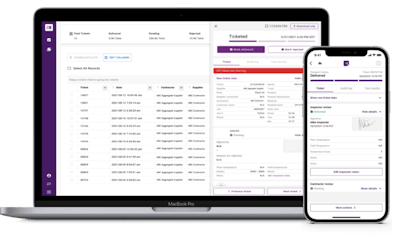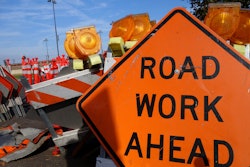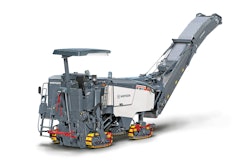
The paperless revolution for road and bridge construction projects is underway, with more than 40 state departments of transportation pledging to adopt some form of electronic ticketing by the end of the year, according to the National e-Ticketing Task Force.
Electronic tickets sent by app, tablet or computer would eventually replace the reams of paper that move to and from the aggregate, asphalt and concrete plants; road and bridge jobsites; and the DOTs. The pandemic, with its need for contactless transactions, has ramped up the desire for e-Ticketing.
That implementation could also be sped along with the new $1 trillion infrastructure law, which includes $100 million for DOTs to advance technologies, such as paperless construction projects, says Matthew Valle, public engagement lead for the National Construction Materials e-Ticketing Task Force.
“This is going to be a really great boost for bringing more innovation into the industry, more startups coming into the industry to try to solve those problems of transitioning from paper-based methodologies into a digital future,” says Valle, who is also industry relations executive for e-Ticketing company HaulHub.
The task force’s goal is the elimination of paper tickets associated with hot-mix asphalt, aggregates and ready-mix concrete throughout the construction industry.
Broad-based support
DOTs have been experimenting with e-Ticketing for years, but a new effort from the Federal Highway Administration’s Every Day Counts program has helped put the effort into high gear. The e-Ticketing EDC initiative has proved to be its most widely adopted in the program’s more than 10-year history, says Valle, speaking recently at World of Asphalt.
“Forty-three state DOTs have said, in some way, shape or form by the end of 2022, we want to be implementing e-Ticketing.”
Since that number was counted, he adds, more DOTs have come on board.
Paperless delivery has also gotten the backing of large industry associations and their members, including the National Asphalt Pavement Association; American Road & Transportation Builders Association; National Stone, Sand & Gravel Association; and National Ready Mix Concrete Association.
“You have the big construction materials along with the transportation construction sector really pushing in this direction,” Valle says. “So it's that blend of the push from the federal side and the state DOTs and the major associations collaborating to push this out across the U.S.”
Taking the lead
DOTs around the country are implementing pilot programs with e-Ticketing.
In Indiana, a $21.2 million resurfacing and bridge rehabilitation project on U.S. 30 in Kosciusko County has been using e-Ticketing through a collaboration among the contractor, materials producer, e-Ticketing vendor and InDOT. They are working to develop a standardized way of feeding the ticketing data to DOT inspectors in the field no matter the material type, the contractor or the vendor.
“Indiana DOT is fully rolling out e-Ticketing across the material supply chain,” Valle says. So far it has most of the hot-mix asphalt plants on the system. Valle expected ready-mix concrete plants to be added in the second or third quarter of this year.
All 16 hot-mix asphalt plants in Delaware are feeding information into DelDOT’s portal, and work is occurring on adding the ready-mix concrete producers, he says.
The Massachusetts Department of Transportation got the ball rolling on the National e-Ticketing Task Force in 2020 by working with several of the largest producer companies and contractors in the state that committed to going paperless. It began to collaborate with its neighboring DOTs in Rhode Island, Maine and New Hampshire through the new task force, led by Greg Nadeau, former FHWA administrator.
“The vision is to bring e-Ticketing to the forefront and really start that conversation, and then bring together the public and private sector to have those conversations and have solutions that are practical and that work,” Valle says.
“It's getting that information from the producers’ point of sale safely, securely, and electronically transmit it across the supply chain … moving from that old-school stack of papers into a more modern, digital future.”
The challenges
 HaulHub has developed The Agency Portal to get digital data to DOTs from contractors and producers regardless of which e-Ticketing vendor and material type they use.HaulHub
HaulHub has developed The Agency Portal to get digital data to DOTs from contractors and producers regardless of which e-Ticketing vendor and material type they use.HaulHub
There are at least a dozen companies that have developed e-Ticketing systems for contractors and producers. For DOT inspectors, that could mean needing a variety of apps and log-ins.
“It quickly became apparent to the DOTs that they needed for their inspectors to have one aggregated solution,” Valle says.
At the same time, they don’t want to mandate what e-Ticketing vendor contractors and producers use. Instead, the DOTs would require certain data fields to be filled out, “leaving the contractors and producers to use whatever they want to use.”
Another challenge is getting contractors onto the DOT systems and making sure they also have access to the information the producer plants are sending in.
After that, it’s a matter of getting the data electronically from the hauler to the rest of the stakeholders. “That's probably a year or so down the road. Once you get this baseline ecosystem set up, then you can start to figure out how do the drivers interact with us," Valle says. "I think there's still going to be paper in the cab for a little bit, just in case they get pulled over and those sorts of things.”
The FHWA also does not want the e-Tickets to be image files that are emailed to DOTs, because they could be altered. “They want source records from the point of sale securely transmitted,” Valle says.
Eventually the FHWA wants the data to be integrated into intelligent construction management models, or building information modeling (BIM). The Pennsylvania Department of Transportation is already heading in that direction, having established its Digital Delivery Directive 2025.
PennDOT’s vision: “By 2025 construction projects will be bid using 3D technology and no longer be in a traditional construction plan format.”
Coupled with e-Ticketing, that will require data standardization to move the 3D models into a platform that can be accessed throughout the supply chain, Valle says. That way, “the producers, contractors, DOTs are all talking the same language and using this information interoperability throughout those various e-Construction tools.”














